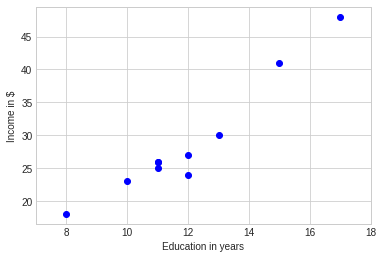Visualize Direction of Relationships
Contents
Visualize Direction of Relationships¶
The correlation falls between -1 and 1 (\(-1 \leq r_{xy} \leq 1\)).
If \(r_{xy} > 0\), the association is positive,
If \(r_{xy} < 0\), the association is negative, and
If \(r_{xy} = 0\), it indicates no linear relationship.
The larger the absolute value \(r_{xy}\), the stronger the association.
Let’s investigate how the scatter plot changes as the correlation changes.
# Importing the necessary libraries
import warnings
warnings.filterwarnings("ignore")
import ipywidgets as widgets
import numpy as np
import pandas as pd
import matplotlib.pyplot as plt
import scipy.stats as stats
plt.style.use('seaborn-whitegrid')
plt.rcParams['figure.figsize']=14,6
# define a corr function with flexible corr input
def corr_widget(corr = 0):
# Defining the mean vector
mean_x_y = np.array([20,30])
# Setting sd and corr
sigma_x = 4
sigma_y = 5
corr_x_y = corr
# Defining the variance-covariance matrix
cov_x_y = np.array([[sigma_x**2, corr_x_y*sigma_x*sigma_y], [corr_x_y*sigma_x*sigma_y, sigma_y**2]])
# Generating a data based on bivariate normal distribution
# with given mean vector and variance-covariance matrix
data = stats.multivariate_normal.rvs(mean = mean_x_y, cov = cov_x_y, size = 100)
# Plotting the generated samples
plt.plot(data[:,0],data[:,1], 'o', c='blue')
plt.title(f'Correlation between X and Y = {corr_x_y}')
plt.xlabel('X')
plt.ylabel('Y')
plt.show()
#turn it into a widget
corr_wid = widgets.FloatSlider(min = -1, max = 1, step=0.1, value=0, description = "$r_x_y$")
#display(corr_wid)
Now, play with the follwing slider to see how correlation changes.
widgets.interact(corr_widget, corr = corr_wid);
Example¶
An educational economist may want to build the relationship between an individual’s income (in $) and education (in years).
S/he takes a random sample of 10 individuals and asks for their income (in $1000s) and education (in years).
The results are shown below:
#present data
data = {'Education': [11,12,13,15,8,10,11,12,17,11],
'Income': [25,27,30,41,18,23,26,24,48,26]}
data
{'Education': [11, 12, 13, 15, 8, 10, 11, 12, 17, 11],
'Income': [25, 27, 30, 41, 18, 23, 26, 24, 48, 26]}
# plot education vs income to explore the relationship
plt.style.use('seaborn-whitegrid')
plt.plot(data['Education'],data['Income'], 'o', c='blue')
plt.xlim([np.min(data['Education'])-1, np.max(data['Education'])+1])
plt.xlabel('Education in years')
plt.ylabel('Income in $')
plt.show()

The scatter plot between the education (in years) and income (in dollars) shows a linear relationship. Let’s compute the sample correlation coefficient \(r_{xy}\) between the education and income.
# get the corr between education and income
corr = np.corrcoef(data['Education'],data['Income'])
# Print the result
print(corr)
[[1. 0.9651672]
[0.9651672 1. ]]
This indicates a strong and positive linear relationship between Education in years and Income.
Session Info¶
import session_info
session_info.show()
Click to view session information
----- ipywidgets 7.7.0 matplotlib 3.5.2 numpy 1.22.4 pandas 1.4.2 scipy 1.8.1 session_info 1.0.0 -----
Click to view modules imported as dependencies
PIL 9.1.1 asttokens NA backcall 0.2.0 beta_ufunc NA binom_ufunc NA cffi 1.15.0 colorama 0.4.4 cycler 0.10.0 cython_runtime NA dateutil 2.8.2 debugpy 1.6.0 decorator 5.1.1 defusedxml 0.7.1 entrypoints 0.4 executing 0.8.3 hypergeom_ufunc NA ipykernel 6.13.0 ipython_genutils 0.2.0 jedi 0.18.1 kiwisolver 1.4.2 matplotlib_inline NA mpl_toolkits NA nbinom_ufunc NA packaging 21.3 parso 0.8.3 pexpect 4.8.0 pickleshare 0.7.5 pkg_resources NA prompt_toolkit 3.0.29 psutil 5.9.1 ptyprocess 0.7.0 pure_eval 0.2.2 pydev_ipython NA pydevconsole NA pydevd 2.8.0 pydevd_file_utils NA pydevd_plugins NA pydevd_tracing NA pygments 2.12.0 pyparsing 3.0.9 pytz 2022.1 six 1.16.0 sphinxcontrib NA stack_data 0.2.0 tornado 6.1 traitlets 5.2.1.post0 wcwidth 0.2.5 zmq 23.0.0
----- IPython 8.4.0 jupyter_client 7.3.1 jupyter_core 4.10.0 notebook 6.4.11 ----- Python 3.8.12 (default, May 4 2022, 08:13:04) [GCC 9.4.0] Linux-5.13.0-1023-azure-x86_64-with-glibc2.2.5 ----- Session information updated at 2022-05-28 16:28
